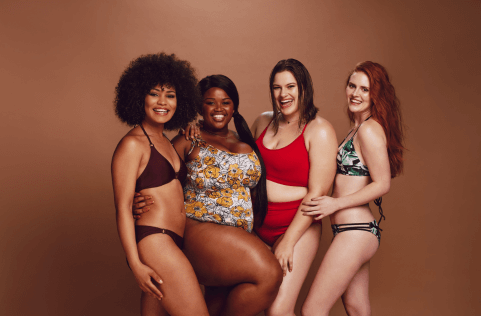As you navigate the world, you are inevitably going to have to navigate your own relationship with your body image. Whether this be a challenging, neutral or positive one - the relationship with your body is one that you have for the rest of your life and can impact how you interact with the world.
Many people have the desire to work towards a more positive body image, however, the idea can be challenging without understanding how we come to develop our own body image in the first place.

what does the research show?
The research shows that body image is a very complex topic because it impacts so many areas of our brain. In fact, a minimum of nine different areas play a role in some component of processing body image - which contribute to the idea that negative body image is more of a collection of multi-dimensional symptoms versus one straightforward answer.
What we do know is that researchers tend to group ways to process body image into three different areas (1), including:
- Perceptive or our perception of our body.
- Affective or the emotional experience of our body.
- Cognitive or the thoughts, ideas and beliefs about our body.
These components really highlight the most challenging part of body image work: body image does not remain stable. Body image is an ever-changing process because of how easily our perception, emotions and thoughts can shift from day to day or even minute to minute. That is why the idea of cultivating a positive body image does not mean simply having a positive experience with your body at all times - it is much more intricate than that.
so, what is positive body image?
Many people in society believe that the idea of positive body image is simply the opposite of negative body image. However, research has found that the idea of positive body image is a much more nuanced topic that comes with its own specific set of criteria that can be formally and informally assessed (2). Understanding the various parts of positive body image can help an individual recognize areas that they feel more confident in and, alternatively, areas that they would ideally like to focus on in their own body image work. Some identified aspects of positive body image include: body acceptance, positive rational acceptance coping, attunement, broad conceptualization of beauty, among others (2). The studies have demonstrated that cultivating a positive body image can have a preventative effect in body image related distress and eating disorders.
Whether you are in recovery from an eating disorder or trying to navigate your own body image - taking time to work on your individual relationship with your body can be hard. And we are here to remind you that you can do hard things. We’ve compiled a few steps to take to help you start your work with body image - let’s dive in!

5 steps to cultivate a more positive body image
assess how you currently view your body (and where it came from)
One of the first steps of change is being able to acknowledge that something is happening. If you are not aware of the current relationship you hold with your body or how that relationship is impacting your life then it can become quite difficult to recognize where to start on your journey towards more positive body image.
Being able to talk through (or maybe write about) your own relationship with your body can give you some solid ground for starting this work. We encourage working with your therapist or a dietitian who is comfortable and trained in body image work to walk through where your relationship or perception of your body comes from.
Living in a society where we are inundated with businesses who profit off of body insecurities, the desire for a certain body type is something that we get exposed to at a young age. This could be through family members, social media, advertisements, TV shows or movies, or social interactions. As you start this journey it is important to recognize the role that these factors have played in your own body image story. And how they may still be impacting your perception of yourself today.
Some potential questions/prompts to ask yourself:
- Can you think back to the first memory of your body - what was that like? How does that compare to your relationship with your body now?
- In relation to your body, what did you learn was acceptable versus unacceptable?
- How do you speak to your body?
- What messages do you get from the outside world about your body?
- What do you believe about your body, shape or size?
recognize what impacts how you feel about your body - and set boundaries!
As you start to review how you currently view your body you can now pay attention to the things that may cause your body image to shift on a day to day basis.
We typically only realize that we are having poor body image thoughts when we are in the midst of a bad mood and our inner bully is raging. An interesting exercise is thinking backwards from when you notice you're having the negative thoughts.
Ask yourself: "What was going on that morning/afternoon/evening - minutes or even seconds before?" Were you engaging in body checking? Scrolling through your Instagram feed? Having a fight with your partner? Maybe talking with a certain friend on the phone?
When you begin to think of your negative body image thoughts as an aftermath for something else that is causing an emotional response, you can start to identify your body image triggers.
Once you have identified some aspects that have contributed to your body image, it’s time to think about where boundaries may be helpful and/or necessary.
Boundary setting is something so critical that we are rarely ever taught growing up. Many fear that they will be perceived as “rude” or “lazy” if they are setting boundaries around work, social or home life.
However, in reality, the act of setting a boundary is saying “hey, I actually need xyz for my own well-being”. And nothing about taking care of yourself is selfish. Remember, you cannot pour from an empty cup.
Some boundary settings could look like: going through and hitting the “unfollow” to social media feeds that no longer serve you or having a conversation with friends or family about conversations that make you feel uncomfortable.
Talk with your team about where boundaries may be helpful for you!
start to build mindfulness skills
When we talk about mindfulness we simply mean: paying attention to something, in a particular way, on purpose, in the present moment without judgement. The act of noticing without judgement or attachment can be so helpful when starting to explore your relationship with your body. Let’s talk about mindfulness in action as it pertains to cultivating a sense of positive body image.
Typically what we see with our clients is some type of internal or external situation triggers negative thoughts, feelings and actions towards the body which are often upsetting and frustrating. Hint: think about the exercise we just did above with some of the potential triggers for your own body image thoughts. This can lead to a spiral of negative thoughts and emotions towards your body.
However, if we pause and insert mindfulness into the situation it can help build awareness of these experiences. And when we are aware we are more likely to build the skills to respond rather than react.
Okay but does this really work?
The good news is - yes! Our brains are incredibly capable of adapting (thank you neuroplasticity) and when faced with repeated actions or approaches to a situation, it can respond as such. If you’re interested - we recommend checking out the work of Dan Siegel for more of a deep dive. Other apps such as Headspace can be a great start for building your own mindfulness practice.
insert some self compassion
Ooof - okay, this one is a big one. The idea of self compassion requires a shifting of intention (hello mindfulness!) to help build a foundation of wanting to take care of oneself. Self compassion is so helpful because it offers an alternative response to our noticing of experience by encouraging us to turn towards ourselves in moments of pain or discomfort through both words and actions.
Research shows it offers a protective factor against poor body image and eating pathology by reducing or moderating risk factors which can impact body image such as body comparison, dieting behavior, thin-ideal internalization (3).
Some ways to start with self compassion are brain-storming some statements that feel good for you such as: “I am doing the best I can right now”.
If this type of internal lingo is unfamiliar to you try role modeling and ask yourself if your dear friend or family member was feeling the same way, what words would you use for them?
check in with your values
Values, at their core, are what is important to you. They are in some ways a guiding light to the life you want to live. When working to cultivate a more positive body image, doing the work to understand your own values can allow you to create actions that are in alignment with “self” rather than in reaction to thoughts and feelings.
One way to start this is to: think about (or google) some values lists; choose your top 2-3 values; use them when more challenging body image thoughts arise. Ask yourself - is this thought or action in line with my current values? Working with your team to navigate the thoughts that come up after these experiments can be extremely helpful.

your next steps with NourishRX
Remember, working to cultivate a more positive body image is a process and something that needs to be continuously returned to and nurtured. Give yourself grace as you move through this process and make sure you feel supported when navigating these difficult conversations with yourself.
If you’re feeling like you need a little more care when moving forward in your body image work, make sure to check out our individualized services and how we can further support you today.
References:
- Cook-Cottone CP. Incorporating positive body image into the treatment of eating disorders: A model for attunement and mindful self-care. Body Image. 2015 Jun;14:158-67. doi: 10.1016/j.bodyim.2015.03.004. Epub 2015 Apr 15. PMID: 25886712.
- Jennifer B. Webb, Nichole L. Wood-Barcalow, Tracy L. Tylka. Assessing positive body image: Contemporary approaches and future directions. Body Image. Volume 14. 2015; 130-145. ISSN 1740-1445 https://doi.org/10.1016/j.bodyim.2015.03.010.
- Braun TD, Park CL, Gorin A. Self-compassion, body image, and disordered eating: A review of the literature. Body Image. 2016 Jun;17:117-31. doi: 10.1016/j.bodyim.2016.03.003. Epub 2016 Mar 31. PMID: 27038782.
Comments Off on How to Improve Body Image